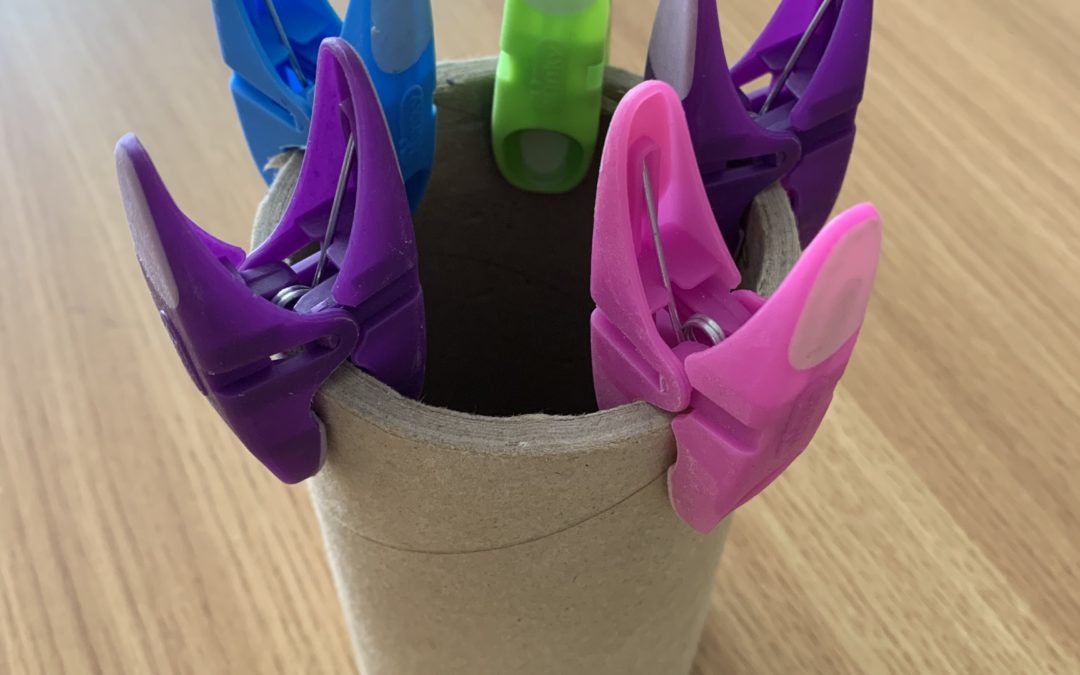Using pegs for fine motor activities is a great way for the development of muscle control in a small child’s hands. You can create many fine motor activities using pegs that don’t cost a lot of money – this is one such activity.
In our special class for autistic pupils, we came across this cardboard tube, I’m unsure what it was used for, and we thought that it would make a perfect early morning fine motor control activity. This was a simple activity – the pupil was given a set amount of clothes pegs in a dish and they had to peg them to the top of the cardboard tube. It sounds simple enough, but if you have poor fine motor control, this could be a challenging activity.
It’s important to understand that autistic pupils need to know when this activity is finished, so by just giving the pupil a set amount of clothes pegs, they will know that they are finished when all of the pegs are attached to the top of the cardboard tube.
There are also many ways in which this activity can be varied or made more challenging for the pupil:
- increase the number of pegs to be attached
- change the type of peg used, varying it with pegs of different textures
- change the size of pegs used, varying it with larger and smaller pegs
- when the pupil has attached all of the pegs to the cardboard tube, get them to return all of the pegs to the peg container
- get the pupil to do this activity using only one hand, varying it between their dominant hand and their weaker hand
- attach small spot stickers near to the top of the cardboard tube, indicating to the pupil where exactly they are to attached the pegs
- attach coloured spot stickers near to the top of the cardboard tube, where the pupil has to match the same coloured peg to the coloured spot
This is just one idea for using clothes pegs to create a simple activity to promote the development of fine motor control.




you are truly a just right webmaster The site loading speed is incredible It kind of feels that youre doing any distinctive trick In addition The contents are masterwork you have done a great activity in this matter
Thanks I have recently been looking for info about this subject for a while and yours is the greatest I have discovered so far However what in regards to the bottom line Are you certain in regards to the supply
Olá, acho que vi que você visitou meu site, por isso vim devolver o favor. Estou tentando encontrar coisas para melhorar meu site. Suponho que não há problema em usar algumas de suas ideias
Hi Neat post There is a problem along with your website in internet explorer would test this IE still is the market chief and a good section of other folks will pass over your magnificent writing due to this problem
Attractive section of content I just stumbled upon your blog and in accession capital to assert that I get actually enjoyed account your blog posts Anyway I will be subscribing to your augment and even I achievement you access consistently fast
Mygreat learning This was beautiful Admin. Thank you for your reflections.
I don’t think the title of your article matches the content lol. Just kidding, mainly because I had some doubts after reading the article.
I do agree with all the ideas you have introduced on your post They are very convincing and will definitely work Still the posts are very short for newbies May just you please prolong them a little from subsequent time Thank you for the post
หากคุณกำลังมองหาเว็บไซต์การพนันออนไลน์ที่ดีที่สุด เราขอแนะนำให้คุณมาที่ Fun88. แอ พ ม อ ถ อ fun88
Tech to Force I really like reading through a post that can make men and women think. Also, thank you for allowing me to comment!
Ductile Iron Pipes in Iraq As one of the most reliable sources for ductile iron pipes in Iraq, ElitePipe Factory is dedicated to providing products of the highest quality. Our ductile iron pipes are engineered for superior strength and flexibility, making them suitable for demanding applications such as water distribution and sewage systems. With advanced manufacturing techniques and rigorous quality control, ElitePipe Factory ensures that each pipe meets the highest standards of performance and durability. Trust ElitePipe Factory for your ductile iron pipe needs and visit our website at ElitePipe Iraq.
Somebody essentially lend a hand to make significantly articles Id state That is the very first time I frequented your website page and up to now I surprised with the research you made to make this actual submit amazing Wonderful task
Kalorifer Sobası odun, kömür, pelet gibi yakıtlarla çalışan ve ısıtma işlevi gören bir soba türüdür.
Thank you for your sharing. I am worried that I lack creative ideas. It is your article that makes me full of hope. Thank you. But, I have a question, can you help me? https://www.binance.com/ar/register?ref=V2H9AFPY
Thank you for your sharing. I am worried that I lack creative ideas. It is your article that makes me full of hope. Thank you. But, I have a question, can you help me?
Your article helped me a lot, is there any more related content? Thanks!
Thanks for sharing. I read many of your blog posts, cool, your blog is very good.
Thank you for your sharing. I am worried that I lack creative ideas. It is your article that makes me full of hope. Thank you. But, I have a question, can you help me?
I don’t think the title of your article matches the content lol. Just kidding, mainly because I had some doubts after reading the article.
Thank you for your sharing. I am worried that I lack creative ideas. It is your article that makes me full of hope. Thank you. But, I have a question, can you help me? https://accounts.binance.com/pt-BR/register-person?ref=YY80CKRN
What i do not realize is in fact how you are no longer actually much more wellfavored than you might be right now Youre very intelligent You recognize thus considerably in relation to this topic made me in my view believe it from numerous numerous angles Its like men and women are not fascinated until it is one thing to do with Lady gaga Your own stuffs excellent All the time handle it up
Insanont I like the efforts you have put in this, regards for all the great content.
Your point of view caught my eye and was very interesting. Thanks. I have a question for you.
Can you be more specific about the content of your article? After reading it, I still have some doubts. Hope you can help me.